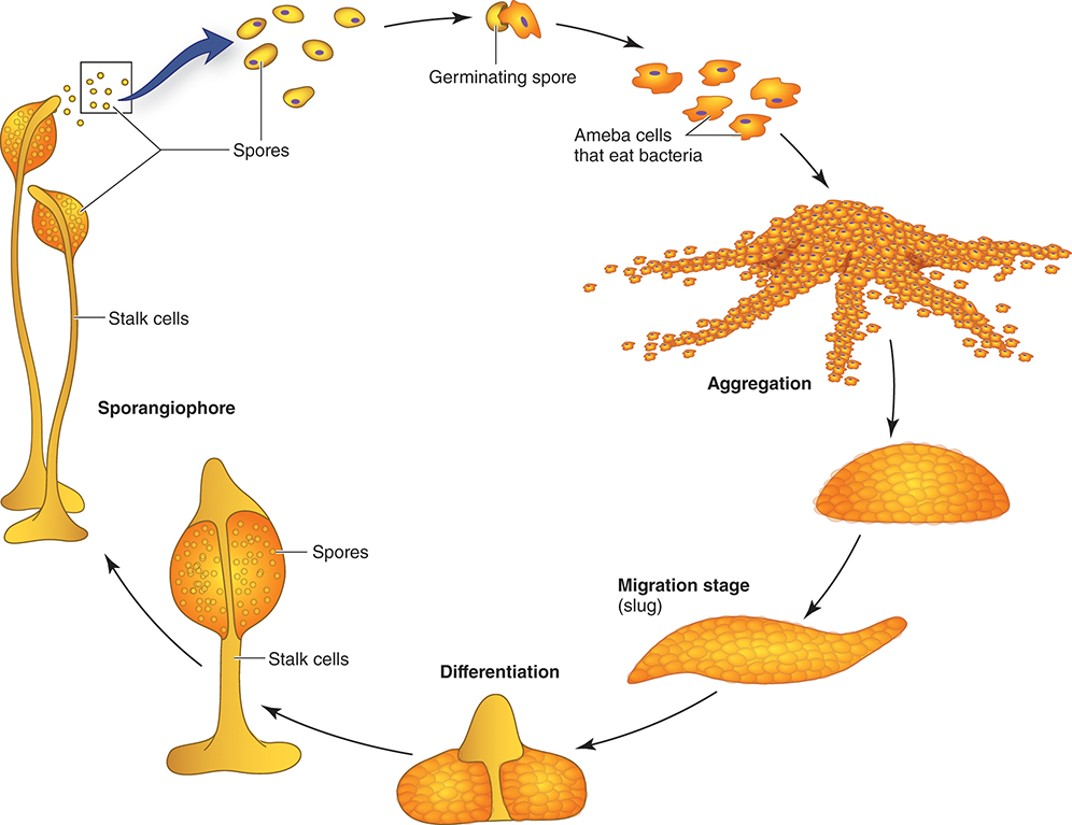LO4: Compare the Diversity of Eucaryotic Microbes
1/57
There's no tags or description
Looks like no tags are added yet.
Name | Mastery | Learn | Test | Matching | Spaced |
|---|
No study sessions yet.
58 Terms
Algae
Are plant-like (no roots, stems or leaves) organisms that practice photosynthesis using energy from the sun and CO2, water and inorganic nutrients from the soil to build cellular material. They contain chlorophyll, which is a pigment that traps light.
Most have a simple cell wall containing cellulose and in addition may have pellicle (thickened cell membrane), and a stigma (light sensing organelle).
Some types possess flagella and are motile.
Are easy to find, and include large seaweeds of various colors, brown kelp found along ocean shores, green scum floating on ponds and slippery green material on wet rocks.
Not all algae are microbes, some are multicellular, for example seaweed, which is visible to naked eye.
Classification of Algae
Depending on the types of photosynthetic pigments they possess, they are classified as green, golden (golden brown), brown or red.
Beneficial Algae
Are an important source of food, iodine, emulsifiers for pudding, stabilizers for ice cream and salad dressings, also gelling agents for jams, alginates, and nutrient media for bacterial growth called agar (from red marine algae).
Are studied by scientists as a source of biofuels, because it is 50% oil.
Harmful Algae
Some are poisonous to fish and to humans and other animals that ingest infected fish or contaminated water.
Cause damage to water systems by clogging filters and pipes.
Cause microbial intoxications by ingesting infected fish, or shellfish such as mussels, scallops, oysters or clams.
One genus lives in the soil and can enter wounds for example on the feet. Can be fatal if it enters the lymph system.
Reproduction of Algae
Reproduce asexually by mitosis and some types reproduce sexually by meiosis.
Protozoa
Do not have cell walls, but some possess a pellicle (thickened cell membrane) which serves same purpose as a cell wall, protection.
Ingest food particles, bacteria, dead, decaying organic matter and move about freely.
Are free-living and saprophytic, and have no chlorophyll, therefore cannot make food by photosynthesis.
Of the nearly 20,000 species, very few cause disease.
Beneficial Protozoa
Some coexist with their host in a symbiotic relationship known as mutualism, wherein both organisms benefit and even depend on one another for survival, for example termites, cattle, goats and their protozoa.
Harmful Protozoa
Some are parasitic and pathogenic to humans.
Can cause Malaria, and Sleeping Sickness, which are transmitted by an infected mosquito.
One species can cause death in AIDS victims.
For example, a waterborne parasitic species causes a diarrhea infectious disease called Cryptosporidiosis. It is transmitted by a nonmotile protozoan that lives outside its host in feces.
Classification of Protozoa
Are classified and divided into groups by their method of locomotion or movement: amoeba, flagellate, ciliate and sporozoan.
Their method of locomotion includes the presence or absence of cilia (thousands of beating short hair like structures for movement) and flagella (have the ability to move).
Another species called an amoeba uses a pseudopodia or a false foot for movement.
Amoeba
Originate in water and soil where people can become infected.
Some are found in the intestines, some have no effect on us.
Some may cause amoebic dysentery.
Capture, surround and engulf food by using their pseudopods or a false foot.
Reproduce by a type of binary fission and sexual methods involving flagellated sex cells.
Move and engulf food by using their pseudopods.
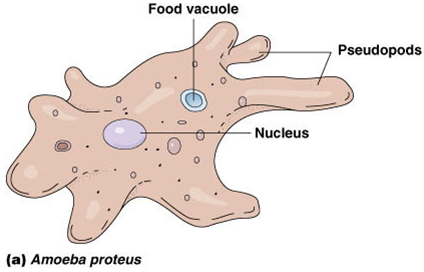
Flagellates
Use flagella to move through the water, like a snake uses its body.
Some are pathogenic and some have no effect on us.
Some animals, including dogs and cats carry this parasite.
Reproduce by a type of binary fission.
Beaver Fever
The parasite is carried by beavers who contaminate water and infect people.
Also known as Giardiasis is spread by eating contaminated food, drinking contaminated water, or through direct contact with the protozoa, Giardia lamblia which can live outside the host in a cyst form mostly in feces. Chlorine does not kill the cysts, water must be filtered.
Common in day care centers, causes diarrhea by fecal/oral route.
This flagellate G. Lamblia causes urinary tract infections.
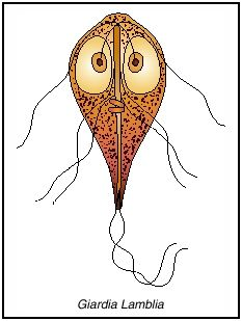
Trichomonas Vaginalis
Lives in the reproductive tract.
Causes irritation to the vaginal membranes and the production of a foul-smelling white discharge.
Is transmitted mainly through sexual contact, as unlike Giardia, which forms a cyst, it is too delicate to survive outside. Men may harbor the infection and spread it.
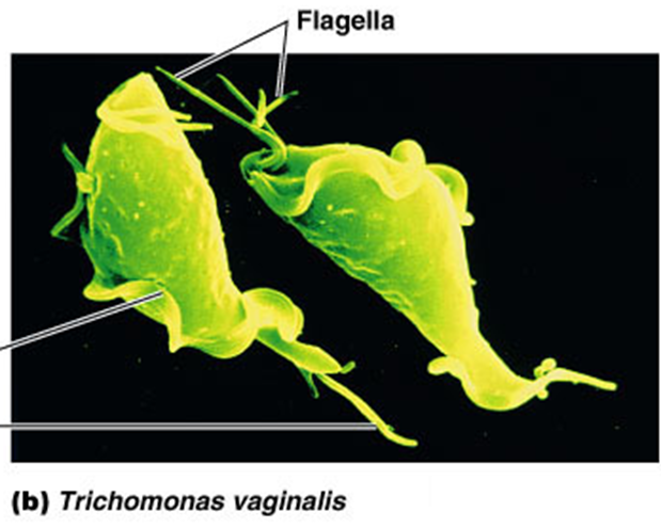
Ciliates
Are the most complex and have a rigid body shape and move about by means of thousands of beating hairs called cilia.
One species lives in the large intestine and causes diarrhea.
One species lives in the gut of termites and aids these animals in digesting wood.
Other species live in the stomach of cattle and helps them digest the grass they eat.
Reproduce by conjugation and a type of fission, not binary fission.
The one in the picture attaches to objects in the water by a stalk.

B. (Banantidium) coli:
The only ciliated protozoa that causes human disease.
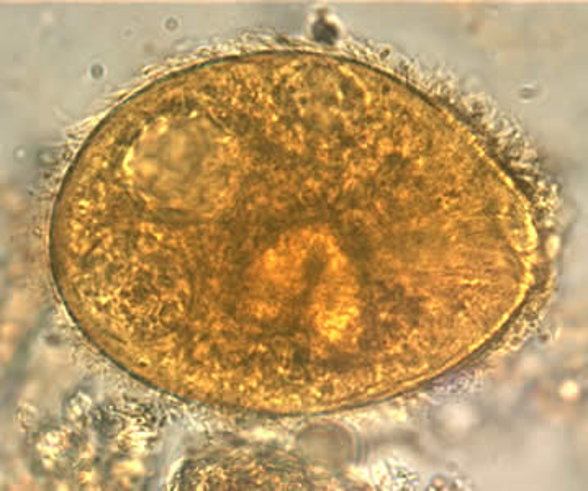
Sporozoan
Are found in all parts of the body and in a wide variety of animal hosts.
Are generally nonmotile.
Are characterized by having complex life-cycles with sexual and asexual generations.
Many species are so small that they are parasites within the cells of their host.
A parasite is an organism that lives on or within another living organism called the host, benefits from host nutrients (food) and may cause it some harm. The damage ranges from minor to fatal disease.
Malaria
Is not a bacteria or virus, but a parasite that multiplies in red blood cells of humans and the mosquito that spreads it through a bite.
The mosquito must have been infected through a previous blood meal taken on an infected person.
They multiply within red blood cells, causing symptoms that include light-headedness, shortness of breath, as well as flu-like symptoms.
Cryptosporidiosis
Is a diarrhea infectious disease caused by a waterborne parasitic species.
Is transmitted by a nonmotile sporozoan that lives outside its host in a cyst form in feces until ingested by a host or any living organism.
Sporozoan produce cysts similar to a spore or capsule for protection from the environment until they are ingested by a new host.
In 1993, the epidemic in Milwaukee was caused by contaminated drinking water; there were 400,000 cases, some fatal.
Sporozoan in image are shown in an acid-fast stain of cryptosporidium in feces.
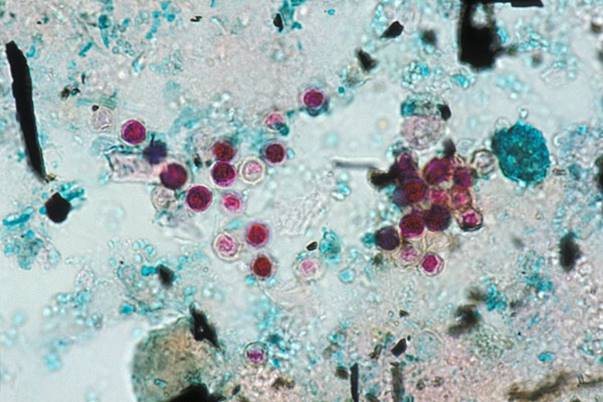
Reproduction of Protozoa
Some protozoa reproduce asexually by a type of fission like bacteria or budding like a yeast.
Others, like the ciliates reproduce sexually by a process called conjugation, which is different from bacterial conjugation or asexually by a type of fission.
Some sexual methods involve flagellated sex cells (amoeba’s and sporozoan).
Types of Flagellates
Beaver fever and Trichomonas vaginalis
Types of Ciliates
B. (Banantidium) coli
Types of Sporozoan
Malaria and Cryptosporidiosis
Fungi
Are not plants (no stems, leaves or roots).
Are not photosynthetic, contain no chlorophyll, can’t get energy from the sun.
Do not have cellulose (algae) in their cell walls; they have chitin in their cell walls.
May be harmful and/or beneficial.
Are eucaryotic cells, which include fleshy fungi (mushrooms, toadstools), mold and yeast.
Fleshy Fungi or Mushrooms
Are not a microbe, and each spore is much like the seed of a plant.
Grow in the soil or a rotting log.
Fruiting body forms and releases spores, which germinate into a new organism.
Are delicious to eat, but some are very toxic causing brain damage or death with a week.
Mold
Is found in water, soil and on food.
Reproduces by spore formation, either sexually (meiosis) or asexually (mitosis).
Assumes colors from pigments in the spores they produce.
Yeast
Are eucaryotic, single-celled organisms that are larger than bacteria.
Are found in soil and water and frequently as a white powdery coating on skins of fruits and vegetables.
May have sexual and asexual cycles. The most common is sexual (mitosis) reproduction by budding. Some yeasts reproduce by fission creating 2 identical daughter cells. In high stress conditions (starvation), cells can undergo sexual (meiosis) sporulation
May look like bacteria, but bacteria do no reproduce by budding or by a spore, nor do they smell like yeast.
The Accidental Discovery of Penicillin
Penicillin is the main source of antibiotics. Soil cultures of mold are grown and isolated to inhibit the growth of bacteria. Many new antibiotics are developed this way, for example penicillin (discovered by Alexander Fleming).
Beneficial Fungi
Many fungi are saprophytic decomposers in nature living on dead/decaying organic matter in water and soil.
As saprophytes, obtain their nutrients from dead and decaying organic matter.
Decompose this material into absorbable nutrients for themselves and others.
Are the original “recyclers” or garbage disposers.
Produce cheese, yogurt, beer and wine, as well as certain drugs and antibiotics, namely penicillin.
Beneficial Mold
Are the flavor of cheeses such as Limburger, Bleu, and Camembert.
Have great commercial importance as the main source of antibiotics, namely penicillin and cephalosporin
Beano is an enzyme made from mold. It breaks down the sugar in vegetables before it can get to the large intestine; therefore no gas.
Beneficial Yeast
Are used to produce vitamins, and the Hepatitis B vaccine (genetically engineered bakers' yeast).
Yeasts break down sugars to CO2 and water under aerobic conditions to leaven or make bread rise.
History of Yeast (1)
In Egypt, wild yeast cells from the air contaminated the dough by accident. People were growing the yeast to make homemade starters for 4000 years. When the mixture bubbled, it was ready for bread making.
In 1865 Charles Fleischmann brings live yeast in a test tube from Hungary to the US.
In 1868, Charles and Max Fleischmann invented a way of growing yeast, harvesting them and putting them into suspended animation cubes with added starch, which had to be refrigerated and used quickly
History of Yeast (2)
During WW2 the active dry yeast was developed to ensure the troops could enjoy bread.
1984 the rapid rise yeast was developed.
In 1993 bread machine yeast was formulated.
Charles Fleischmann, died in 1897 and is buried in Cincinnati, Ohio
In 1857, Louis Pasteur discovered that yeast is alive and lives all around us.
Yeast produces yogurt, makes bread rise and are responsible for the fermentation process used to produce wines and beer. The powdery coating (yeast) on grapes causes fermentation process, which is an anaerobic condition or no oxygen required, to produce wines.
Harmful Fungi
Some are parasitic, living on or in animals and plants, not necessarily causing harm, but they can. These parasites, obtain their nutrients from the living organisms.
Some are pathogenic or toxic to humans and animals through ingestion of contaminated food or via airborne routes (lung infections), causing superficial, cutaneous, subcutaneous and systemic mycoses.
Can grow with very little moisture, for example on leather, on outside of fruits or newspaper.
Harmful Fungi VS Bacteria
Can cause deterioration in plastics, and spoilage in jams, and pickles. Very few bacteria are found on fruits, too acidic. Bacteria don’t spoil jams, not enough moisture on outside of fruits, grains or vegetables.
Are more resistant to osmotic pressure than bacteria; therefore they can grow in high sugar and salt content and acidic environments. When preserving, add sugar to make canned fruit and salt to make pickles.
Harmful Mold
Causes a variety of plant diseases, including smuts of crop plants, grains, corn, and potatoes, as well as rusting of equipment.
Are toxic to humans and animals through ingestion of contaminated food or via airborne routes (lung infections).
Causes deterioration in plastics, and spoilage in apple juice, jams, pickles and is responsible for the fluffy green mass on bread. An immunosuppressed person could die from inhaling bread mold.
Symptoms of Black Mold
Nasal congestion, headaches, runny nose, coughing.
Is it safe to remove mold?
Is it safe to remove mold from food such as cheese, jams, sour cream or yogurt and eat it? Think of mold on food like a huge jellyfish…you can see the top and then there are tentacles underneath that you can't see.
The Potato Famine
Mold caused the great potato famine in Ireland in 1845-48 causing the death through starvation and malnutrition of over 1 million people.
800,000 were forced out of their homes because they had no money to pay rent.
2 million left for the US and other countries, many died aboard ship enroute.
Some blamed “little people” or the devil.
1861 Antoine De Bary proved it was a fungus that caused the blight.
1st disease know to be caused by a microbe.
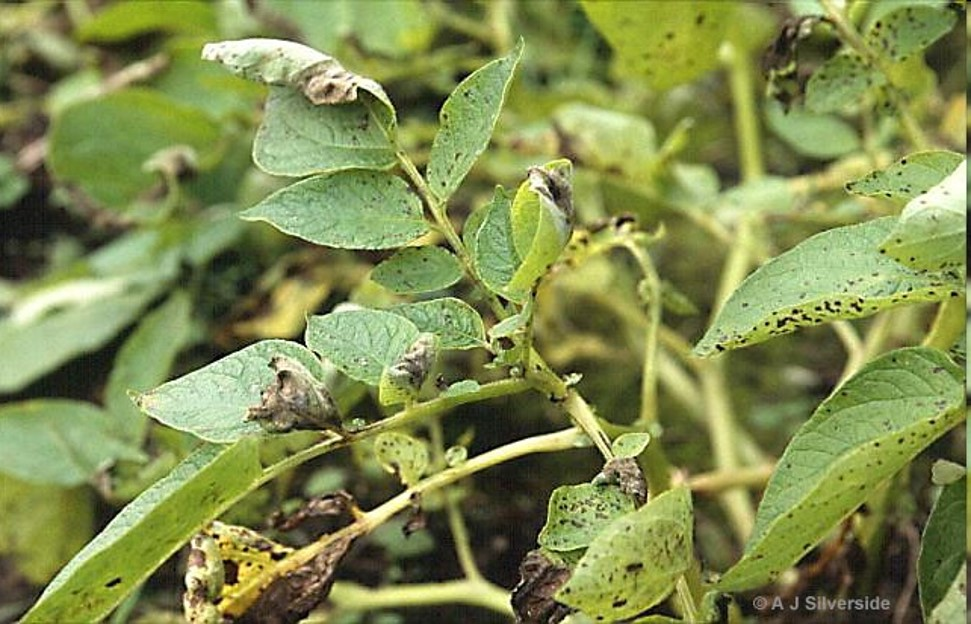
Harmful Yeast
May be pathogenic to humans, for example, the opportunist Candida albicans, which causes thrush, nail infections, vaginitis, denture stomatitis.
Reproduction of Fungi
Classified by their methods of reproduction.
Is by budding or formation of spores, sexual and asexual spores.
Are separated into classes based on the mode of reproduction or they types of sexual spores that they produce or the type of structure on which spores are produced.
Budding
The cell becomes swollen at one edge and a new cell or bud develops and breaks away from the parent to live independently (a method of mitosis). Image below shows Budding and colonies of the yeast Candida albicans.
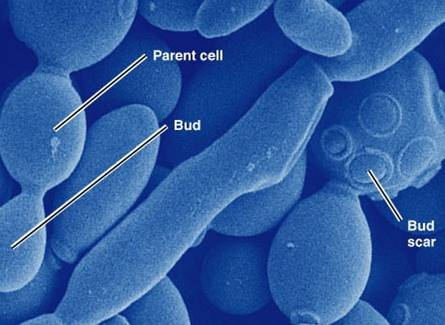
Sporulation
Is a type of reproduction which includes the formation of spores by division of the cell into 4 or more daughter cells, each of which contains a portion of the original nucleus (mitosis).
Fungal Spores
Are similar to bacterial spores, but not as tolerant and neither do they have the longevity of bacterial spores.
Are resistant to heat, cold, and acid and can be carried long distances by the wind causing allergies in some.
Are common in Arizona and inhaled by seniors that spend winters there.
Can cause serious lung infections as dust storms can be severe.
Reproduction in Fleshy Fungi/Mushrooms
Fruiting body forms and releases spores, which germinate into a new organism.
Each spore is much like the seed of a plant.
Reproduction in Mold
Reproduce by spore formation, either sexually (meiosis) or asexually (mitosis).
Reproduction in Yeast
May have sexual and asexual cycles. Most common is asexual (mitosis) reproduction by budding.
Some yeasts reproduce by fission creating 2 identical daughter cells.
In high stress conditions, (starvation) cells can undergo sexual (meiosis) sporulation.
Fungal Diseases
Are called mycoses which are chronic or long lasting infections.
Are difficult to cure, because the antifungal agents used to treat the disease are very toxic to humans.
Fungi, like human cells are eucaryotic. The drugs kill fungal infection as well as human cells.
Classification of Fungal Diseases
Are classified according to how involved the tissue is and the portal of entry into the host:
1. Systemic mycoses
2. Subcutaneous mycoses
3. Cutaneous mycoses
4. Superficial mycoses
5. Opportunistic mycoses
Systemic Mycoses
Most severe type affects internal organs, bloodstream and respiratory tract.
Cryptococcosis is a disease of the lungs and spreads via the blood stream to the brain, caused by a yeast found in pigeon droppings. The dried yeasts are inhaled.
Also includes chicken, turkey and bat droppings, and soil contaminated with bird droppings.
Subcutaneous Mycoses
Affect the underlying tissues.
Sporotrichosis lives in the soil and can be acquired by farmers or gardeners. The spores become implanted in a puncture wound in the skin.
They are known as dimorphic fungi and can live as either yeast or mold, depending on growth conditions.
Cutaneous Mycoses (mold)
Affect the living layers of the skin, for example tinea infections named by part of the body they infect. Ex) athletes foot and ringworm
Superficial Mycoses
Affect the dead outermost layers of the skin, hair, fingernails and toenails.
Cutaneous Opportunistic Mycoses
The yeast candida albicans, which is normally harmless, flourishes out of control if the indigenous microbiota decreases. It can enter the blood stream and become systemic.
The opportunist Candida albicans, may be pathogenic to humans, for example, causing thrush, nail infections, vaginitis, denture stomatitis.
In this case, it has been given the opportunity to cause infectious disease.
Algae VS Plants
Both are eucaryotic cells.
Both are photosynthetic.
Both cells contain chlorophyll.
Both use CO2 as an energy source.
Both store energy in the form of starch.
Algae have no roots, stems or leaves.
Most algae have cells walls that contain cellulose.
Algae reproduce asexual and sexual.
All plants have roots, stems and leaves.
All plants have cells walls that contain cellulose.
Plants only reproduce sexual.
Protozoa VS Algae
Both are eucaryotic cells.
Algae contain chlorophyll and make their own food via photosynthesis.
Algae are plantlike.
Algae have cellulose in their cell walls.
Algae are classified by color.
Some algae may produce toxins.
Protozoa are largest of the microbes, animal-like found in soil and water.
Protozoa have no cell wall, but some possess a thickened cell membrane.
Protozoa have no chlorophyll and can’t make their own food by photosynthesis.
Protozoa ingest food particles, algae, yeasts, bacteria, dead and decaying organic matter.
Protozoa are categorized by method of locomotion.
Some protozoa are saprophytic and parasitic and pathogenic to humans.
Fungi VS Algae
Both are Eucaryotic cells.
Fungi are not photosynthetic, have no chlorophyll to make their own food.
Fungi are saprophytic decomposers.
Fungi are parasitic on animals and plants.
Fungi cause human mycoses and plant diseases.
Fungi have chitin in their cell walls.
Fungi reproduce by budding and sporulation.
Algae have cellulose in their cell wall.
Algae produce toxins that cause infectious disease in humans and animals.
Algae reproduce by mitosis and meiosis
Lichen
Are observed as colored, often circular patches on tree trunks and rocks.
Are composed of algae or cyanobacteria and a fungus living in a mutualistic relationship.
The algae, because it is a green plant, can photosynthesize and provide energy
The fungus contributes to the relationship by obtaining water and minerals and by protecting the algal cells from desiccation.
Slime Mold
Is found in soil and on rotting logs.
Has both fungal and protozoal characteristics.
Starts out life as an amebae, ingesting bacteria and fungi by phagocytosis.
When the food runs out they fuse together to form a motile form called a slug.
The slug consists of a stalk and spore cap and each spore becomes an amebae.
Images show that it grows on anything and the life cycle.
